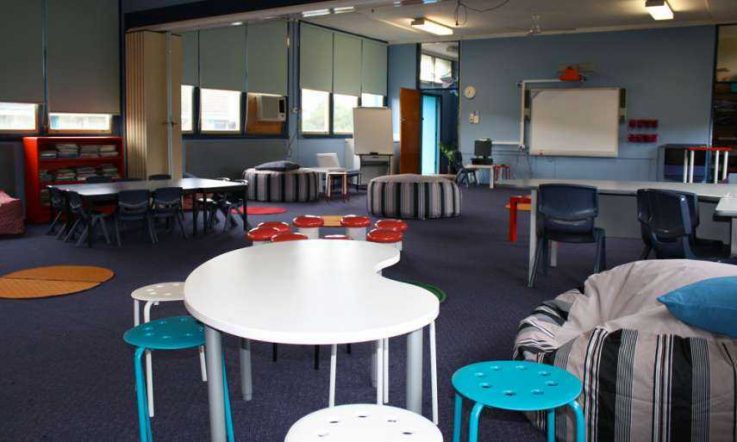This article was originally published in the May 2011 print edition of Teacher.
School students are spending more time on computers at school and at home than ever before. While there are real benefits to integrating technology in the classroom, there are also dangers. Most schools have strategies in place to deal with the most obvious risks of cyberbullying and access to inappropriate content, but the risks to students’ physical health may be overlooked because the effects are less immediate.
More time spent on the computer potentially means more time spent slouching or straining, and this can lead to back and neck pain and musculoskeletal disorders such as such as tension neck syndrome, repetitive strain injury and occupational overuse syndrome.
Research on adult computer use has found that people who spend long hours sitting at desks run an increased risk of developing musculoskeletal disorders. Researchers say this is because of the sustained contractions of the muscles in the neck, back and arms responsible for maintaining a rigid posture.
The risk of injury is higher for people involved in technology-based tasks because we tend to move less, for example, when staring at a fixed-height computer monitor with hands resting on a keyboard than when using pen and paper.
Further, long-term physical damage is even more likely to affect school students than office workers, simply because children and young adults experience a period of rapid growth in spinal structures, which means effects on posture at this time are intensified.
Outside of school, this lack of postural variation is aggravated for students who also spend time engrossed in computer-based pastimes such as playing games, surfing the internet, social networking, and, yes, some of them might even be doing their homework.
Inside the classroom, ignorance exacerbates the problem. Schools recognise the importance of information and communication technology (ICT) but funding is typically allocated to the most obvious resources, such as computer hardware and software, with little money spent on training or ergonomic furniture. Teachers are often not trained to be aware of optimal workstation set-up; simple, practical details like adjusting chairs to the height of the user, positioning computer keyboards and monitors at the right distance, and taking regular breaks to move and stretch.
So, while the days of strict schoolteachers admonishing kids to ‘sit up straight’ after a full day of sitting at excruciatingly uncomfortable flip-top wooden desks may be gone, attention to posture and correct workstation design is still essential in schools.
Increasingly, schools are recognising that students need ergonomic furniture and equipment, as well as training in correct workstation set-up and safe work practices.
Computer usage and its effects
A 2006 study of the effect of workstation design on Western Australia schoolkids, ITKids, found that nearly 40 per cent of students aged between 11 and 14 used a computer for more than an hour a day, including five per cent of students that used a computer for more than three hours a day. It seems likely that these percentages would have increased substantially since the survey was completed.
The National Assessment Program – ICT Literacy, for example, found that the percentage of Year 10 students using a computer daily at school rose from 18 per cent in 2005 to 32 per cent in 2008. If this trend continues, the 2011 assessment is likely to find that an even greater proportion of students now uses computers every day at school.
Research links extended computer use to higher incidence of pain and injury. In the ITKids study, almost half of the students admitted to having neck or shoulder pain. Those with very high levels of computer use were twice as likely to complain of muscle pain.
The use of laptop computers is particularly problematic. Students who have laptops tend to spend longer logged on than students using desktop computers. Courtenay Harris and Leon Straker’s ‘Survey of physical ergonomics issues associated with school childrens’ use of laptop computers’ found that students in schools with mandatory laptop programs spent on average more than three hours per day on the computer.
Laptops are also designed more for convenience than for comfort; because the screen height and keyboard position can’t be adjusted to suit the user, laptops may be more likely to cause pain and injury than desktop computers – especially for older (taller) children. Sixty per cent of students in schools with compulsory laptop computer programs reported discomfort as a side effect of extended computer use.
And, while laptops may reduce the number of textbooks and notebooks that students have to carry, incorrect carrying of the laptop itself may contribute to pain. Sixty per cent of students in the survey reported discomfort from carrying their laptops.
The risk of discomfort and injury can be reduced, however. There are a range of measures that schools, teachers and students can implement to prevent poor posture and minimise the likelihood of students developing musculoskeletal disorders.
Child ergonomics
Children may be at their most susceptible to physical disorders caused by inappropriate furniture during adolescence, says one of leading researchers in the field, Professor Leon Straker, Director of Research in the School of Physiotherapy at Curtin University. ‘Ergonomics is really important for school children,’ he says. ‘Before they finish high school, two thirds of children would have experienced their first episode of back or neck pain. Having back or neck pain as a child makes you more likely to have chronic back or neck pain as an adult.
‘By the time children leave school they have over a decade of habit forming – how they sit, how they use computers, how they ensure variety in their day. Childhood is where people need to learn safe working habits,’ says Straker.
Straker, together with colleagues from the University of Queensland, Washington University and Harvard University, has recently published ‘Evidence-based guidelines for wise use of computers by children.’ These have been made freely available to the public by the publishers at www.informaworld.com
In the guidelines Straker outlines some key points for good ergonomics in school to help reduce the onset of musculoskeletal pain and discomfort:
- design the day so children get a posture change every half hour
- make sure children can lie, sit or stand in a reasonably comfortable position for any task – the longer the task the more comfortable the posture should be
- encourage children to wear their school bag comfortably on both shoulders
- encourage children to be active
- encourage positive, collaborative peer interactions
- encourage children to feel free to move to reduce discomfort, and to report early discomfort to the teacher, and
- encourage children to be active after school and on weekends, and not sit and play sedentary electronic games or watch television for more than 30 minutes without playing an active game for a while.
Furniture and equipment
Ergonomic chairs, variable-height work surfaces, and computer accessories are designed to protect people from a variety of musculoskeletal disorders. Look for products designed specifically for children and young adults: smaller people need smaller furniture!
Adjustable work surfaces
Because classrooms are used by a variety of students, tables and chairs should be able to be adjusted.
Desks
Computer desks should be deep enough so that the computer screen can be positioned about an arm’s length from the student; wide enough to allow the keyboard and mouse to sit side-by-side; and high enough that the student can sit comfortably with unrestricted leg movement. Foot stools can be used when desks and chairs are not able to be adjusted enough to fit the child, but this is a ‘second class’ solution.
Chairs
Chairs should have height adjustment mechanisms, but nothing so delicate that students will destroy it on the first day of school. If the chair has a back rest it should be adjustable to support the lower back. Chairs should not have armrests as they tend to block students from getting close to the desk. Details such as waterfall fronts and flexible backrests allow students to vary their position, shift their weight and relieve pressure points.
Computer accessories
Keyboards should be in good condition so keys work well and have a positive feel when the key is actuated. Ideally keyboards should not have number pads as these make the child have to reach out to the side to use a mouse, and thus be more likely to get soreness in their shoulder. The computer mouse should be hand-sized for the child and be kept clean so it moves smoothly over the desk and buttons work smoothly. Document holders reduce eye and neck strain.
Making do
Many school classrooms across the country today were designed before the invention of computers and possibly, for some, prior to the invention of electricity. In reality, not all schools will have the budget to replace every old chair, desk and keyboard with an ergonomic miracle. The best compromise is to accommodate the majority of students. The height of the chair, in relation to the student and the height of the desk, is the most important factor in correct posture; so try to have a range of chairs in different sizes, preferably with height-adjustment mechanisms.
In practice, although price will inevitably be an important deciding factor in a school’s furniture choice, unlimited resources are not necessary for a healthy ergonomic environment.
Workstation set-up
Adjust the chair and table so that the student’s elbows are at the same height as the desk with feet flat on the floor. For a shorter student, this may mean that his feet do not touch the floor; in this case, a footrest needs to support his feet to keep the thighs parallel to the floor.
Adjust the height of the computer monitor so that the top of the screen is level with the student’s eyes. The mouse and keyboard should be positioned close together and in front of the student. They can be pushed back from the edge of the desk to allow the forearms to rest on the desk to allow the student’s neck, shoulders and arms to relax more. Centre the letters of the keyboard, not the entire keyboard, in front of the student.
The student’s upper arms should be close to the body and relaxed; her wrists should be at a neutral position, level with the forearms. Her head should be balanced on her neck, not tilted forward or back, with her chin neither tucked in nor stretched forward.
One good posture involves the student forming 90-degree angles in the positions: between her shoulder, hip and knee; between her shoulder, elbow and wrist; and between her hip, knee and foot.
Students like to collaborate. If possible, cluster workstations together so students can work collectively.
As a teacher, be aware of where you stand and move, and where you position whiteboards or projection screens. If you want students to see you, position yourself where they can see you and their computer screens at the same time.
Training
Knowing how to sit at a workstation in a way that prevents strain on neck and shoulder muscles and the spine is essential to avoid injury. Thoughtful workstation setup, good computer work habits and posture awareness are simple, low-cost, effective ways to minimise the risk.
Take regular breaks
Make sure that your class takes a few moments every 20 minutes to stop what they’re doing, stand up and stretch to restore circulation, relieve tense muscles, and break up periods of inactivity.
Take micropauses
Students generally type in bursts rather than steadily. Between bursts, students should relax their hands, resting them straight and flat.
Vary tasks
Set diverse types of work to avoid students experiencing long periods of repetitive movements and stressful postures.
Use shortcuts
Encourage students to use keystrokes rather than the repetitive action of using the mouse, trackpad or joystick, which puts strain on hands and wrists.
Set an example
You don’t have to say ‘sit up straight’ – in so many words. Do encourage students to sit tall with back straight, head straight, shoulders relaxed and both feet flat on the ground. Discourage crossed legs. Sitting correctly, there should be a curve in the small of the back.
Let them complain
Be on the lookout for signs of computer-related injury in students: warning signs include pain, tingling or heaviness in the neck, shoulders, back, arms, elbows, wrists or hands.
Tech up
Working at a computer can be hypnotic, so several companies have developed software that can monitor how much you’ve been using the computer, prompt you to take rest breaks and to stretch, provide postural advice and suggest exercises.
Laptops
Laptops are fundamentally an ergonomic challenge because they can’t be adjusted for individuals: the keyboard, pointing device and monitor of a laptop or tablet computer are integrated in one unit, so it is more difficult to maintain a comfortable posture that doesn’t strain the neck, shoulders, arms and hands. For most primary school children the smaller size of the keyboard and closeness of the keyboard and monitor actually gives them a better posture than using a desktop computer setup for a tall child or adult. However for older, taller children it is impossible to get a good posture with a laptop – but using an external keyboard and mouse gives the child the flexibility to put monitor and keyboard in positions to encourage good posture.
Encourage students to set up laptops following similar rules to those used for desktop computers. To minimise strain, laptops should be used on tables or desks, rather than actually in the lap. Using laptops away from desks can be a good way to allow some different, good, postures to be used and to give some variety, as long as the laptop posture follows the guidelines.
Encourage the same safe work practices for use with a laptop as for use with a desktop computer. Ensure students take frequent breaks, stretch, use keyboard shortcuts and are aware of the importance of their posture.
iPads and iPods
Touchscreen devices such as smart phones and iPads are being used by some schools and are used by many children. These devices have similar problems to laptop computers, and the small screen ones should only be used for short periods. iPads and electronic books usually result in poor neck postures – like when reading any small book. Typing into touch screens may also be more stressful than normal keyboards but research on this is currently being conducted.
Straker and his colleagues plan to develop child-, parent- and teacher-friendly versions of the guidelines this year, and to make these freely available on the internet.
References
Harris, C., & Straker L. (2000). “Survey of physical ergonomics issues associated with school childrens' use of laptop computers.” International Journal of Industrial Ergonomics 26(2): 337-347.
Straker L., Maslen B., Burgess-Limerick R & Johnson P, Dennerlein J. (2010) Ergonomics. Evidence-based guidelines for the wise use of computers by children: physical development guidelines 53(4): 458-77.
Wise, M., Straker L.M., Mathiassen S., & Pollock C.M. (2006) ITKids: Variation in muscle activity among school children when using different information and communication technologies. The Human Factors and Ergonomics Society of Australia, 42nd Annual Conference. New Technology: Putting a macro & Micro into Context. November 20, 2006, Sydney, NSW: The Human Factors and Ergonomics Society of Australia.
This article was originally published in the May 2011 print edition of Teacher.


